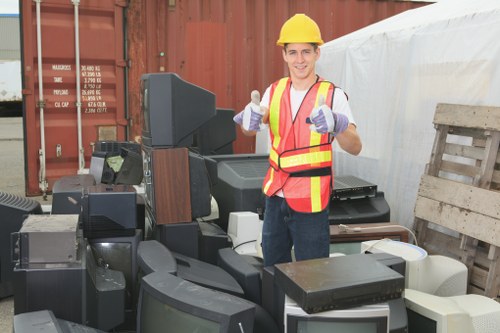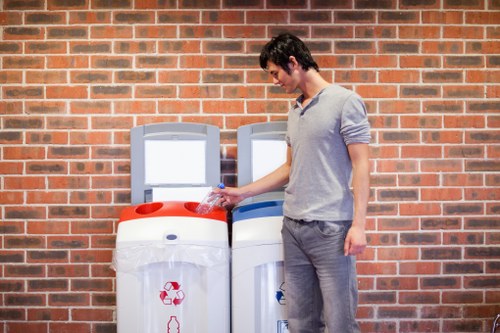Efficient Construction Waste Clearance in Forest Hill
Understanding Construction Waste Clearance

Construction projects generate a significant amount of waste, which can include materials like concrete, wood, metals, and plastics. Proper construction waste clearance in Forest Hill is essential not only for maintaining a clean and safe worksite but also for ensuring environmental sustainability.
Effective waste management involves the systematic process of collecting, transporting, and disposing of construction debris. This process helps in reducing the environmental impact and promoting recycling and reuse of materials whenever possible.
Failing to manage construction waste properly can lead to increased project costs, delays, and potential legal issues due to non-compliance with local regulations.
Why Choose Professional Services?

Opting for professional construction waste clearance services in Forest Hill offers numerous advantages. Professionals have the expertise and equipment necessary to handle large volumes of waste efficiently.
They ensure that waste is sorted correctly, allowing for maximum material recovery and minimal landfill disposal. This not only benefits the environment but also can lead to cost savings for your project.
Additionally, professional services stay updated with the latest regulations and best practices, ensuring that your construction site remains compliant and operates smoothly.
Types of Construction Waste

Understanding the different types of construction waste can help in planning an effective clearance strategy. Common types include:
- Concrete and Masonry: Often requires specialized handling for recycling.
- Wood and Timber: Can be repurposed or recycled into new products.
- Metals: Highly recyclable and valuable as scrap material.
- Plastics: Recyclable but requires careful sorting.
- Drywall and Insulation: Can sometimes be recycled but often end up in landfills.
Proper categorization and disposal of these materials are crucial for efficient waste management.
The Clearance Process

The construction waste clearance process typically involves several key steps:
- Assessment: Evaluating the type and volume of waste generated.
- Sorting: Separating recyclable materials from non-recyclable ones.
- Collection: Gathering the sorted waste for transportation.
- Transportation: Moving the waste to recycling centers or disposal sites.
- Disposal: Ensuring that non-recyclable waste is disposed of in an environmentally responsible manner.
Each step requires careful planning and execution to ensure efficiency and compliance with local regulations.
Benefits of Proper Waste Clearance

Implementing a robust waste clearance strategy offers several benefits:
- Environmental Protection: Reduces the impact on natural resources and minimizes landfill usage.
- Cost Efficiency: Lower disposal costs and potential revenue from recyclable materials.
- Regulatory Compliance: Avoid fines and legal issues by adhering to waste management laws.
- Enhanced Site Safety: Maintains a tidy work environment, reducing accidents and improving productivity.
- Corporate Responsibility: Demonstrates commitment to sustainable practices, enhancing your reputation.
These advantages make investing in professional construction waste clearance a wise decision for any project.
Choosing the Right Service Provider

Selecting the right construction waste clearance service in Forest Hill involves several considerations:
- Experience: Look for companies with a proven track record in handling construction waste.
- Certification: Ensure the provider complies with local and national waste management regulations.
- Equipment: Adequate and modern equipment is essential for efficient waste clearance.
- Recycling Practices: Providers committed to recycling contribute to sustainability efforts.
- Customer Support: Responsive and reliable customer service can make the process smoother.
Taking the time to research and choose the right provider can significantly impact the success of your waste management strategy.
Environmental Impact

The environmental impact of construction waste is substantial. Landfills are becoming overburdened, and improper disposal can lead to soil and water contamination.
By opting for effective waste clearance, you help mitigate these negative effects. Recycling materials not only conserves natural resources but also reduces greenhouse gas emissions associated with manufacturing new products.
Adopting sustainable waste management practices is crucial for protecting the environment and ensuring the longevity of our natural ecosystems.
Cost Considerations

Managing construction waste can seem like an added expense, but in the long run, it can lead to significant savings. Proper waste clearance reduces the amount of material sent to landfills, lowering disposal fees.
Recycling and reusing materials can also provide financial returns, offsetting some of the initial costs involved in waste management.
Moreover, efficient waste management can prevent costly delays and fines related to non-compliance with environmental regulations.
Regulatory Compliance

Adhering to local and national waste management regulations is non-negotiable. Failure to comply can result in hefty fines and project shutdowns.
Professional waste clearance services are well-versed in these laws and ensure that your project remains compliant throughout its lifecycle.
This not only safeguards your project but also contributes to the broader effort of sustainable development.
Recycling and Reuse

Recycling and reusing construction materials is a key component of sustainable waste management. Materials like concrete, metals, and wood can be repurposed for new projects, reducing the demand for virgin resources.
Engaging in recycling practices also lowers the environmental footprint of your construction activities, aligning with global sustainability goals.
Many professional waste clearance services offer comprehensive recycling solutions, making it easier for you to participate in these initiatives.
Innovative Waste Management Solutions

The construction industry is continually evolving with new technologies and methods to manage waste more effectively. Innovations such as on-site recycling facilities and advanced sorting technologies enhance the efficiency of waste clearance.
Implementing these solutions can lead to faster turnaround times, higher recycling rates, and reduced overall waste.
Staying updated with these advancements ensures that your waste management practices remain top-notch.
Case Studies: Success Stories in Forest Hill

Several construction projects in Forest Hill have successfully implemented effective waste clearance strategies. These case studies highlight the tangible benefits of proper waste management.
For instance, a recent commercial development achieved a 70% recycling rate by partnering with a local waste clearance service, significantly reducing their environmental impact.
Another residential project minimized landfill waste by reusing materials and optimizing their waste segregation process, leading to cost savings and enhanced sustainability.
Future Trends in Waste Clearance

The future of construction waste clearance is moving towards greater sustainability and circular economy practices. Trends include increased automation in waste sorting, greater emphasis on material recovery, and the integration of waste management with overall project planning.
Moreover, there is a growing focus on reducing waste generation at the source through improved construction techniques and better project management.
Staying ahead of these trends can position your projects as leaders in sustainable construction.
How to Get Started

Initiating an effective waste clearance strategy involves several steps:
- Assess Your Needs: Determine the volume and types of waste your project will generate.
- Choose a Service Provider: Select a reputable waste clearance service in Forest Hill that meets your requirements.
- Plan the Process: Develop a clear plan outlining how waste will be collected, sorted, and disposed of.
- Implement Recycling: Incorporate recycling practices to maximize material recovery.
- Monitor and Adjust: Continuously monitor waste management processes and make necessary adjustments for improvement.
Following these steps ensures a smooth and efficient waste clearance process.
Conclusion

Effective construction waste clearance in Forest Hill is a critical aspect of any construction project. It not only ensures compliance with environmental regulations but also promotes sustainability and cost efficiency.
By partnering with professional waste clearance services, you can manage construction debris efficiently, reduce your environmental footprint, and contribute to a cleaner, safer community.
Don't wait—contact us today to streamline your construction waste management and ensure the success of your next project.